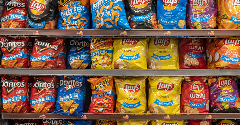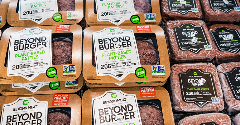News
IFIC: American consumers care about food origin
16 Jan 2019Consumers crave a deeper understanding of what they are eating, and want to learn more about the origins of their food and its entire journey from farm to fork, according to the International Food Information Council (IFIC) Foundation.

While consumers cite broad aspects like taste, price and familiarity as the top reasons to purchase certain foods, they also crave a deeper understanding of what they are eating. Americans want to learn more about the origins of their food and its entire journey from farm to fork, according to the International Food Information Council (IFIC) Foundation.
“Americans have a growing appetite for more information about their food, and technology is enabling eaters like never before,” said Joseph Clayton, CEO of the IFIC Foundation. “It’s also driving transparency across the food supply chain.” IFIC Foundation predicts that 2019 will bring a larger focus on the food journey, greater attention to food safety and allergens, continued consumer concern about sugar and increased popularity of plant-based eating.Discovering Our Foods’ Origin StoriesConsumer interest and awareness of the origins of their food used to start and stop at the grocery store or restaurant. Today that’s a thing of the past. Consumers want to know how their food is produced, where it came from and the quality of the ingredients. They also have broader questions about environmental sustainability and many seek brands that align with their broader social values. The 2018 Food and Health Survey revealed over half of respondents indicate recognizing the ingredients, understanding where food is from and the number of ingredients as key factors that impact purchasing decisions. Interestingly, women were more likely to rate these factors as more important when compared to men. In addition, compared to 2017, more Americans cited that understanding how the food is produced altered their decision to buy a food or beverage.From seeds planted to crops harvested to products sold and served, we seem to crave a 360-degree picture of what we’re eating.Tackling Food Safety with TechnologyTracing the source of food contamination within the supply chain is central to food safety. Food safety concerns dominated the news last year, with two dozen food safety outbreaks investigated by the Centers for Disease Control and Prevention — the highest amount of outbreaks in more than a decade. However, this does not mean that the U.S. food supply is less safe. Instead, our ability to detectcontamination of food (i.e., traceability) has improved dramatically. One technology that has improved rates of traceability is the whole-genome sequencing (WGS) technique. WGS generates the complete DNA sequence of an organism, which allows for distinction between and among different pathogens. Its resolution is far superior than technologies used in the past; some food safety experts believe WGS-based surveillance is about 100 times better at detecting outbreaks than two decades ago.Food Allergies: Actions and ReactionsWGS also stands to make positive contributions in the area of food allergens, such as peanuts. Using WGS data from patients with a peanut allergy might help identify peanut allergies in young babies before they can pose life-threatening anaphylactic reactions. Additionally, WGS can be used to detect trace amounts of allergens in foods.Food allergies are also attracting more attention on the regulatory front because the FDA is looking into labeling sesame as an allergen.Expect those discussions to move closer to center stage in 2019.There’s No Sugar-Coating This TrendIf you had to name one thing that you should eat less of, most people would probably say sugar. According to the 2018 Food and Health Survey, more than fat, protein or carbohydrate, sugar is to blame for packing on a few extra pounds, with 33% believing that it is the calorie source most likely to cause weight gain (up from 20% in 2012).The sweet stuff remains top-of-mind for many Americans, and people are responding to dietary guidance that recommends eating less added sugar. Seventy-seven% say they are taking steps to limit or avoid sugars in their diet, and 59% view sugars negatively. In addition, the mandatory compliance date for labeling added sugars on the Nutrition Facts panel is now less than a year away (January 1, 2020). Coupling the current negative consumer sentiment on sugars with more information about them included on food packaging leads us to believe the sugar reduction trend will continue in 2019.As a result, we could also see growing popularity of low and no-calorie sweeteners, particularly stevia leaf extract and monk fruit sweeteners due to their appeal as plant-based alternatives to sugar.Voracious Vegetarians and VegansPlant-based eating is flourishing in American diets, with sales growing by 20% since 2017, a trend that shows few signs of abating. While only 4% of Americans identify as vegetarians or vegans, according to the 2018 Food and Health Survey, many others cite following diets that are typically high in veggies, such as paleo (7%), low-carb (5%), Whole30 (5%) and high protein (4%). Also, vegetables are the second most popular food or food component people are seeking to provide health benefits (7%), behind protein (10%). This interest in plant-based eating can also be applied to specific macronutrients. For example, the 2018 Food and Health Survey, nearly 70% of Americans stated that protein from plant sources is healthy, while less than 4 in 10 report that animal protein is healthy. This trend doesn’t seem to be going away anytime soon as sales of plant-based milk alternatives and meat alternatives continue to expand each year.Related news

PepsiCo formulates ‘naked’ Cheetos and Doritos products
31 Dec 2025
US food giant PepsiCo has launched its Simply NKD range, a move it says reimagines its popular products with new formulations free from artificial flavours, dyes, and colours.
Read more
Debate over ban on ‘meaty’ names for plant-based products reaches stalemate
26 Dec 2025
The debate over a ban on plant-based products using “meaty” terms has reached a stalemate, leaving manufacturers in limbo and still facing overhauls to their marketing and packaging.
Read more
Has ‘clean’ had its day?
22 Dec 2025
Wielding clean-label positioning and fortification as marketing levers is a dangerous strategy, and brands would be better off explaining the hows and whys of the ingredients in their products, say experts.
Read more
Bigging up bean-based products and consumption in Britain
19 Dec 2025
Non-profit organisation the Food Foundation has launched a campaign, “Bang in Some Beans”, designed to increase UK consumers’ legume consumption.
Read more
Ingredient transparency key to success in European natural health market
12 Dec 2025
Europe’s $40.7 billion supplements market is growing fast, fuelled by demand for products that support healthy ageing, mental wellbeing, and preventive health, say experts.
Read more
Sorghum emerges as better-for-you hero ingredient
9 Dec 2025
With the launch of Novak Djokovic’s sorghum-based brand, the grain’s popularity in the better-for-you snacking sphere is on the rise, thanks to its nutritional and sensory properties.
Read more
Innovation promise in 'maturing' plant-based dairy alternatives market
8 Dec 2025
Plant-based dairy is a maturing market that still faces significant hurdles around taste, functionality, nutrition, and price, but industry is innovating fast, according to experts speaking at Fi Europe.
Read more
Celebrating the winners of the Fi Europe Innovation Awards 2025
3 Dec 2025
Food industry stakeholders celebrated as the winners of the Fi Europe Innovation Awards were announced at a ceremony in Paris.
Read more
Yuka’s food scanning app helps consumers make healthier choices
2 Dec 2025
Global food scanning app Yuka helps consumers understand the content of their shopping baskets and shapes producers’ reformulation plans.
Read more
Non-UPF Program extends certification scheme to entire food industry
30 Nov 2025
The Non-UPF Program has extended its certification scheme to the wider food sector, championing a move towards healthier consumption habits.
Read more